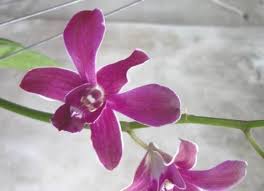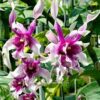# How to Fix Yellowing Leaves in Dendrobium Orchids

Dendrobium orchids, known for their stunning flowers and varied species, are a popular choice among orchid enthusiasts. However, yellowing leaves can be a common issue that indicates an underlying problem. In this article, we will explore the causes of yellow leaves in Dendrobium orchids, methods to diagnose the problem, and effective strategies to restore these beautiful plants to health.
## 1. Understanding Dendrobium Orchids
### 1.1 Overview of Dendrobium Orchids
Dendrobium orchids belong to one of the largest genera in the Orchidaceae family, with over 1,800 species. They are characterized by their unique pseudobulbs, which store water and nutrients, and their stunning, diverse flowers that can vary in color, shape, and size. Dendrobiums are native to tropical and subtropical regions, making them well-suited for indoor and greenhouse cultivation.
### 1.2 Ideal Growing Conditions
For Dendrobium orchids to thrive, they require specific environmental conditions:
– **Light**: They prefer bright, indirect sunlight. Insufficient light can lead to poor growth and yellowing leaves, while excessive direct sunlight can cause leaf burn.
– **Temperature**: Optimal temperatures range from 65°F to 85°F (18°C to 29°C). Sudden temperature changes can stress the plant, leading to various health issues.
– **Humidity**: Dendrobiums thrive in humidity levels of 40% to 60%. Low humidity can result in dehydration, while high humidity can promote fungal diseases.
– **Watering**: These orchids require a well-draining potting medium and should be watered thoroughly, allowing the medium to dry slightly between waterings.
Understanding these conditions is crucial for identifying why leaves may turn yellow and how to remedy the situation.
## 2. Causes of Yellow Leaves in Dendrobium Orchids
Yellowing leaves in Dendrobium orchids can result from several factors. Understanding these causes is the first step to diagnosing and treating the issue.
### 2.1 Nutrient Deficiencies
Nutrient deficiencies are one of the most common reasons for yellowing leaves. Dendrobium orchids require a balanced supply of essential nutrients, including nitrogen, potassium, phosphorus, calcium, and magnesium.
– **Nitrogen Deficiency**: Nitrogen is vital for leaf growth and chlorophyll production. A lack of nitrogen will cause older leaves to turn yellow, starting at the tips and moving inward.
– **Iron Deficiency**: Iron is crucial for chlorophyll synthesis. When deficient, new leaves may turn yellow while the veins remain green, a condition known as interveinal chlorosis.
### 2.2 Overwatering and Root Rot
Overwatering is a frequent mistake made by orchid growers. When the potting medium remains too wet, it can lead to root rot, which prevents the roots from absorbing nutrients effectively. Symptoms include:
– Yellowing leaves, particularly lower leaves.
– Soft, mushy roots that may appear black or brown.
### 2.3 Underwatering
Conversely, underwatering can also cause yellow leaves. When Dendrobiums do not receive enough water, they can become stressed, leading to leaf yellowing and dropping. Signs include:
– Dry, shriveled leaves.
– A potting medium that is completely dry.
### 2.4 Light Issues
Light levels significantly impact the health of Dendrobium orchids.
– **Insufficient Light**: If the orchid does not receive enough light, older leaves may start to yellow and drop. The plant may also appear leggy, with elongated stems as it reaches for more light.
– **Excessive Light**: Conversely, too much direct sunlight can cause sunburn, leading to yellow or brown spots on leaves.
### 2.5 Temperature Stress
Extreme temperatures can affect the overall health of Dendrobium orchids.
– **High Temperatures**: Prolonged exposure to high temperatures can cause leaf yellowing and drop, particularly if humidity levels are low.
– **Low Temperatures**: Cold drafts or exposure to temperatures below 50°F (10°C) can cause stress, resulting in yellowing leaves.
### 2.6 Pests and Diseases
Pests and diseases can also cause yellowing leaves. Common pests include aphids, mealybugs, and spider mites. These pests suck sap from the leaves, leading to discoloration and weakness.
Diseases such as bacterial or fungal infections can also contribute to yellow leaves. Symptoms may include:
– Soft, mushy spots on leaves.
– Mold or mildew growth on leaves or in the potting medium.
### 2.7 Environmental Factors
Environmental stressors, such as pollution or drafts, can impact the health of Dendrobium orchids, leading to yellowing leaves.
– **Air Pollution**: Pollutants in the air can damage leaves and hinder photosynthesis, leading to yellowing.
– **Drafts**: Cold drafts or sudden changes in environmental conditions can stress the plant and result in yellowing leaves.
## 3. Diagnosing the Problem
To effectively address yellowing leaves in Dendrobium orchids, it’s essential to diagnose the underlying problem.
### 3.1 Inspecting the Plant
Begin by examining the plant closely:
– **Leaves**: Check for patterns in yellowing. Are older leaves turning yellow, or is it the new growth? Is the yellowing uniform or spotty?
– **Roots**: Gently remove the orchid from its pot to inspect the roots. Healthy roots should be firm and green. Brown, mushy roots indicate root rot.
### 3.2 Assessing Growing Conditions
Evaluate the plant’s growing conditions:
– **Light Levels**: Consider the light conditions where the orchid is located. Is it receiving adequate, indirect light?
– **Watering Schedule**: Reflect on your watering habits. Are you watering too frequently or not enough?
– **Temperature and Humidity**: Check the temperature and humidity levels in the environment to ensure they are within the ideal range for Dendrobiums.
### 3.3 Soil and Nutrient Analysis
Examine the potting medium:
– **Soil Type**: Ensure the potting mix is appropriate for Dendrobium orchids. It should be well-draining, allowing excess water to escape.
– **Fertilizer Application**: Assess your fertilization routine. Have you been using a balanced fertilizer?
### 3.4 Pest Inspection
Look for signs of pests or diseases:
– **Pest Presence**: Check for visible pests on the leaves and in the potting medium. Look for sticky residue or webbing, which can indicate pest infestations.
– **Disease Symptoms**: Identify any unusual spots or discoloration on the leaves that may suggest a fungal or bacterial infection.
## 4. Solutions for Yellowing Leaves
Once you’ve diagnosed the issue, it’s time to implement solutions to restore your Dendrobium orchid’s health.
### 4.1 Adjusting Nutrient Levels
If nutrient deficiencies are identified, consider the following steps:
– **Fertilization**: Use a balanced, water-soluble fertilizer specifically designed for orchids. A fertilizer with a higher nitrogen content can help address nitrogen deficiency.
– **Foliar Feeding**: For quick absorption of nutrients, consider foliar feeding with a diluted liquid fertilizer. Spray it directly on the leaves for immediate benefits.
– **Soil Amendments**: If necessary, amend the potting mix with organic matter, such as compost or well-rotted manure, to improve nutrient levels.
### 4.2 Correcting Watering Practices
To remedy overwatering or underwatering issues, implement these strategies:
– **Watering Schedule**: Develop a consistent watering schedule based on the plant’s needs and environmental conditions. Allow the potting medium to dry slightly between waterings.
– **Potting Medium**: Ensure the potting medium is appropriate for orchids. Consider using a mix of bark, perlite, and sphagnum moss for improved drainage.
– **Drainage**: Ensure pots have adequate drainage holes to prevent water from accumulating in the bottom. Consider repotting if necessary.
### 4.3 Adjusting Light Exposure
If light levels are inadequate or excessive, take the following actions:
– **Relocate the Plant**: Move the orchid to a brighter location with filtered light if it’s not receiving enough light. Conversely, provide shade if it’s getting too much direct sunlight.
– **Use Sheer Curtains**: For orchids exposed to strong sunlight, consider using sheer curtains to diffuse the light and protect the leaves from burning.
### 4.4 Temperature and Humidity Management
To manage temperature and humidity levels effectively:
– **Temperature Control**: Ensure the orchid is kept within the optimal temperature range. Avoid placing it near heating vents or air conditioning units that can cause sudden temperature changes.
– **Humidity Increase**: Use a humidifier to maintain humidity levels or place a tray of water near the orchid to increase humidity through evaporation.
### 4.5 Pest and Disease Control
To manage pests and diseases, follow these guidelines:
– **Pest Treatment**: Use insecticidal soap or neem oil to treat pest infestations. Apply the treatment according to the product instructions and ensure thorough coverage of the affected areas.
– **Disease Management**: If fungal or bacterial infections are suspected, remove affected leaves and treat with a fungicide or bactericide as necessary.
– **Sanitation**: Maintain cleanliness in the growing area by removing fallen leaves and debris that can harbor pests and diseases.
### 4.6 Environmental Adjustments
To protect your Dendrobium orchid from environmental stressors:
– **Avoid Pollution**: Position the orchid away from sources of air pollution, such as busy roads or industrial areas.
– **Draft Protection**: Ensure the orchid is not placed in drafty areas or near doors
and windows where cold air can stress the plant.
## 5. Preventative Measures
Once you have successfully treated yellowing leaves in your Dendrobium orchid, consider implementing the following preventative measures to maintain its health:
### 5.1 Regular Monitoring
Regularly check your Dendrobium for signs of yellowing leaves, pests, or diseases. Early detection can prevent larger issues down the line.
### 5.2 Consistent Care Routine
Establish a consistent care routine that includes watering, fertilizing, and inspecting your orchid for pests and diseases.
### 5.3 Research and Education
Stay informed about the specific needs and care requirements of your Dendrobium orchid species. Knowledge about their unique characteristics will help you provide the best care.
## Conclusion
Yellowing leaves in Dendrobium orchids can be concerning, but understanding the causes and implementing effective solutions can restore the health and vitality of these beautiful plants. By maintaining proper care and monitoring conditions, you can ensure that your Dendrobium orchids continue to thrive, showcasing their stunning blooms for years to come. Regular observation and adjustments in care can lead to a flourishing orchid that brings joy and beauty to any home.

